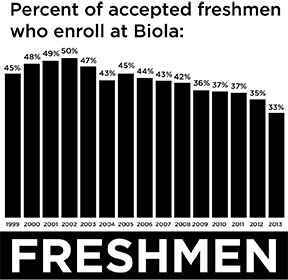
Admissions data chronicling the past 15 years of enrollment at Biola shows a 10 percent decline in admitted students who enroll, from 44.89 percent in 1999 down to 33.44 percent in 2013. However, the number of potential students offered admission continues to grow, reaching its highest-ever benchmark at 2,700 in 2013.
This means that although the number of students who apply and get accepted is increasing, the number of students who actually choose to go to Biola has dropped.
WHY STUDENTS AREN'T CHOOSING BIOLA
Andre Stephens, senior director of undergraduate admissions, said the school is puzzled by the findings.
“We’re actually trying to do some research on that right now,” he said. “Is this unique to Biola, or is this happening across the board with our competitive set [of colleges]?”
Biola has already admitted 2,000 students for fall 2014, according to associate undergraduate admissions director Brad Camilleri. He said the enrollment goal for next semester is 1,380 students, a jump of 85 students from last year’s 1,295.
In trying to discern why a student would choose not to enroll at Biola, Camilleri believes the most common reason is relative value.
“If you really boiled it down, it would be because they didn’t believe Biola was worth what it would cost for them, relative to another opportunity,” he said. “They’re weighing the cost of Biola versus the perceived value.”
KEEPING PROSPECTIVE STUDENTS INTERESTED IN ENROLLING
Part of the strategy to keep prospective students interested in enrolling is faster admissions decision-making to allow students adequate time to make financial and enrollment choices, according to Camilleri.
“We don’t want anyone who applies to choose to go elsewhere because they felt not as wanted here or cared for. So what we’re trying to do is improve efficiency in our process so they don’t have to wait as long to hear back about their admissions decision,” he said.
The effort is two-pronged, according to Camilleri, and in addition to quicker admittance responses, Biola is attempting to figure out financial aid faster. Students who do not know how much financial aid they can receive early on will often choose other schools if given a better offer, Camilleri said.
“What we’re heading [up] is the financial aid conversation,” he said. “The financial aid office is working hard to get offers sent out early, so students can know financially where they stand.”
The lowered enrollment numbers can be seen across higher education. Total enrollment for degree-granting post secondary institutions rose 46 percent between 1996 and 2010, but is projected to only increase 15 percent by 2021, according to a report by the National Center for Education Statistics.
While the problem may be a country-wide one, Camilleri said at least part of the solution stems from the school itself.
“Some of this can be explained by broader trends in higher ed, but part of our role is to ensure that we are serving each student well as they come through the process … so that ultimately they’re choosing us at an acceptable rate,” he said.







